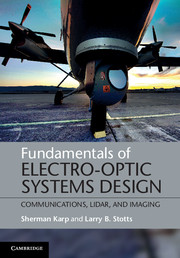Book contents
- Frontmatter
- Contents
- Preface
- Notation
- 1 Genesis of electro-optic systems
- 2 Role of electromagnetic theory in electro-optics systems
- 3 Photo-detection of electromagnetic radiation
- 4 Metrics for evaluating photo-detected radiation
- 5 Contrast, visibility and imaging
- 6 Signal modulation schemes in optical communications
- 7 Forward error correction coding
- 8 Modern communications designs for FOC/FSOC applications
- 9 Light detection and ranging
- 10 Communications in the turbulence channel
- 11 Communications in the optical scatter channel
- Appendix A Two-dimensional Poisson processes
- Appendix B Propagation of finite beams in water
- Appendix C Non-Lambertian scattering
- Appendix D Communications noise sources besides signal/background shot noise
- Index
- References
1 - Genesis of electro-optic systems
Published online by Cambridge University Press: 05 February 2013
- Frontmatter
- Contents
- Preface
- Notation
- 1 Genesis of electro-optic systems
- 2 Role of electromagnetic theory in electro-optics systems
- 3 Photo-detection of electromagnetic radiation
- 4 Metrics for evaluating photo-detected radiation
- 5 Contrast, visibility and imaging
- 6 Signal modulation schemes in optical communications
- 7 Forward error correction coding
- 8 Modern communications designs for FOC/FSOC applications
- 9 Light detection and ranging
- 10 Communications in the turbulence channel
- 11 Communications in the optical scatter channel
- Appendix A Two-dimensional Poisson processes
- Appendix B Propagation of finite beams in water
- Appendix C Non-Lambertian scattering
- Appendix D Communications noise sources besides signal/background shot noise
- Index
- References
Summary
When we decided to write this book about the design of electro-optic systems, we agreed to make it as fundamental as possible. To do this in detail would most probably make the book unwieldy. Rather, we will try to motivate all aspects of the design from fundamental principles, stating the important results, and leaving the derivations to references. We will take as our starting point the first two Laws of Thermodynamics [1]. The Three Laws of Thermodynamics are the basic foundation of our understanding of how the Universe works. Everything, no matter how large or small, is subject to the Three Laws. The Laws of Thermodynamics dictate the specifics for the movement of heat and work, both natural and man-made. The First Law of Thermodynamics is a statement of the conservation of energy – the Second Law is a statement about the nature of that conservation – and the Third Law is a statement about reaching Absolute Zero (0° K). These laws and Maxwell’s equations were developed in the nineteenth century, and are the foundation upon which twentieth-century physics was founded.
- Type
- Chapter
- Information
- Fundamentals of Electro-Optic Systems DesignCommunications, Lidar, and Imaging, pp. 1 - 18Publisher: Cambridge University PressPrint publication year: 2012



